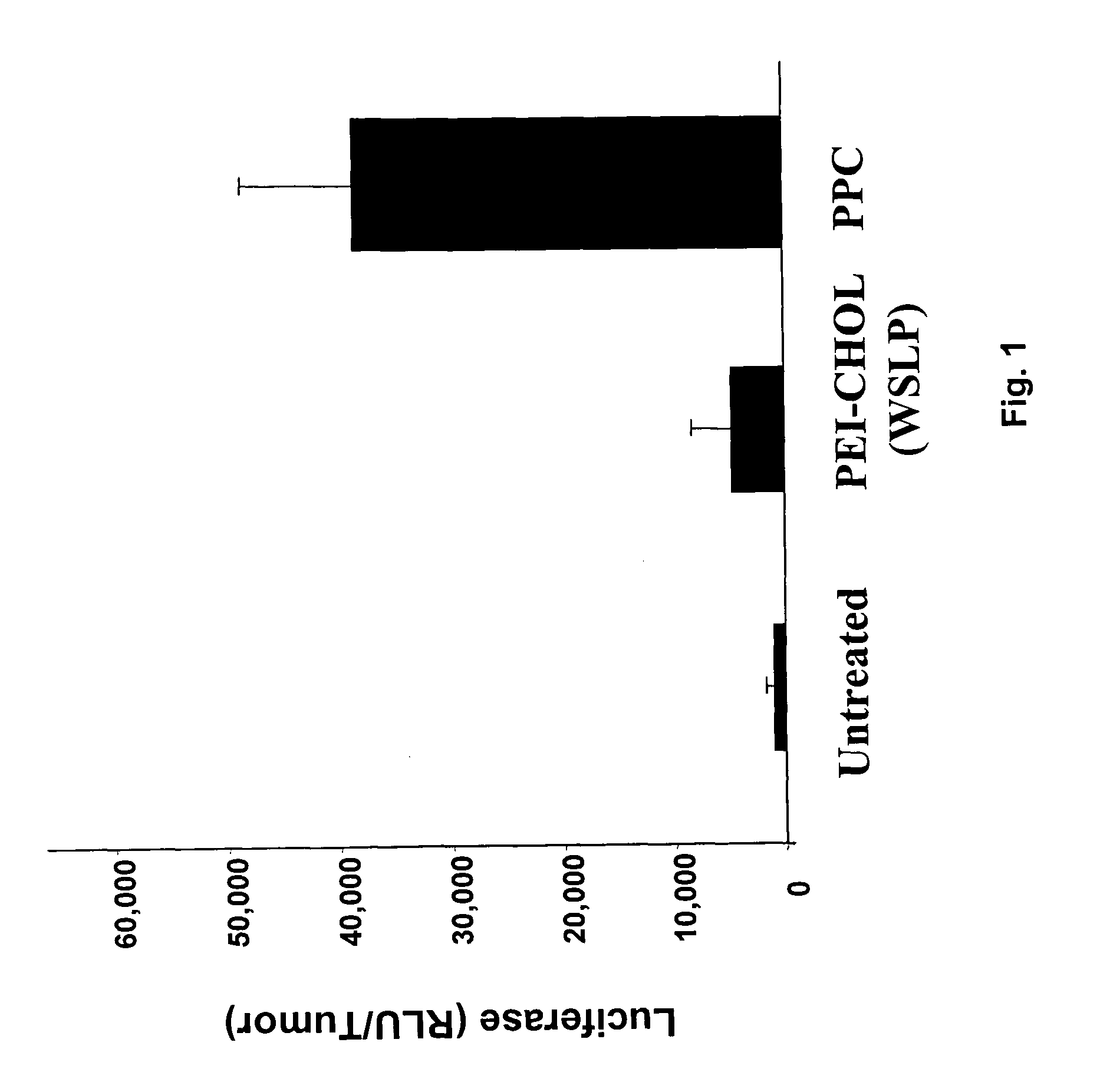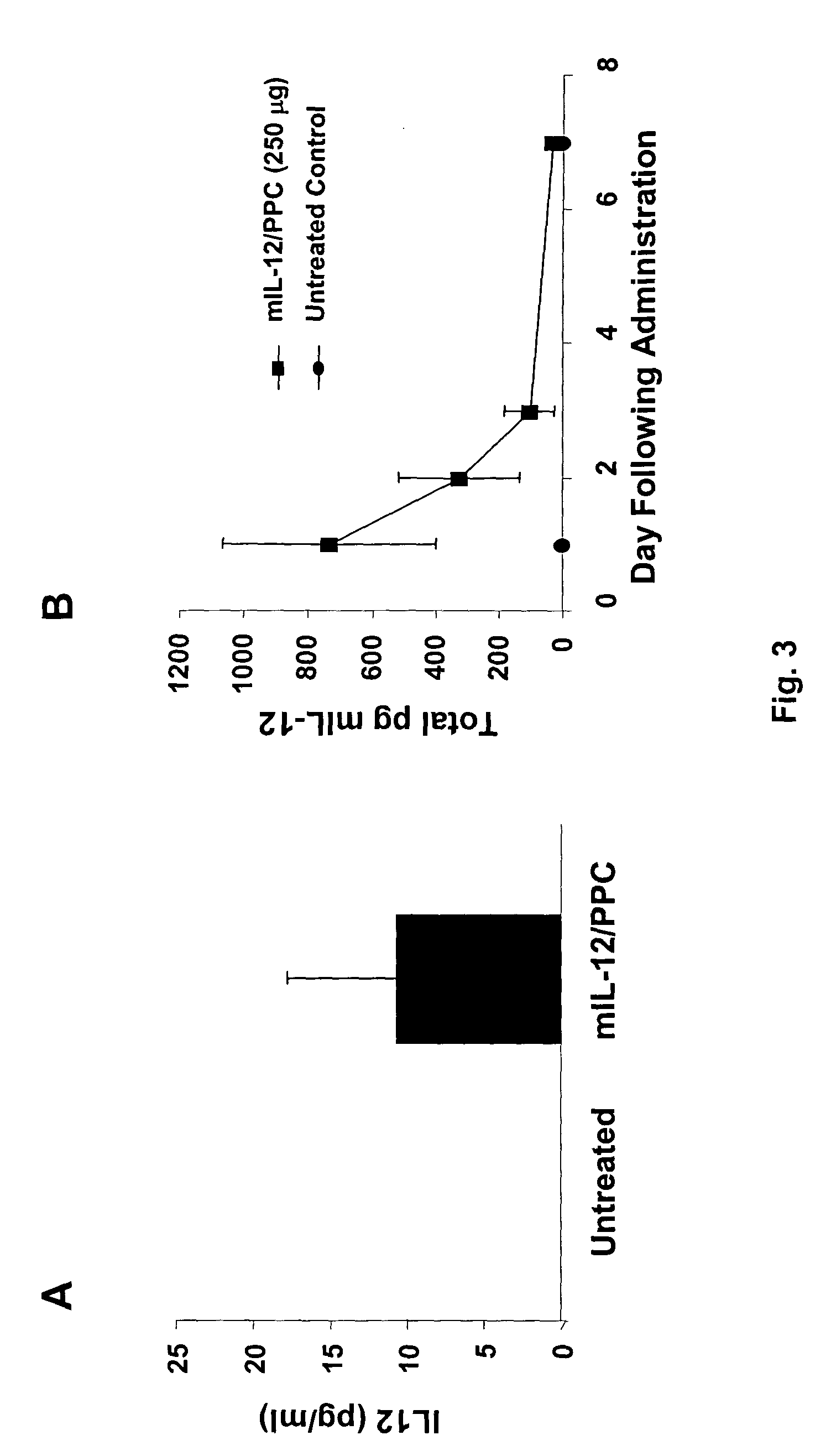Combination of immuno gene therapy and chemotherapy for treatment of cancer and hyperproliferative diseases
a technology of immuno gene therapy and chemotherapy, applied in the direction of amide active ingredients, heavy metal compound active ingredients, drug compositions, etc., can solve the problems of not treating the root cause of the disease, undesirable side effects, undesirable side effects, etc., and achieve tumor shrinkage and prolong the life span
- Summary
- Abstract
- Description
- Claims
- Application Information
AI Technical Summary
Benefits of technology
Problems solved by technology
Method used
Image
Examples
example 1
IL-12 Gene Transfer into Peritoneal Disseminated or Subcutaneous Tumors by Local Administration of pIL-12 / PPC Complexes
The ability of local delivery of pIL-12 / PPC complexes to produce IL-12 levels in subcutaneous and peritoneal disseminated tumor bearing mice was examined. For subcutaneous tumor studies, female BALB / c mice (7 weeks, 14-18 grams) mice were injected subcutaneously (sc) in the left and right flanks, with 1×106 4T1 cells each. After the tumors had reached an approximate tumor size of 60 mm3 they were injected with pmIL-12 / PPC complexes containing 6 μg of DNA. The mice were sacrificed 24 hours later and their tumors harvested for mIL12 analysis by ELISA. The mIL-12 levels in tumors 24 hours after the injection are shown in FIG. 3A.
For peritoneal tumor studies, female C57 / BL6 mice were injected intraperitoneally (ip) with 5×106 ID8 cells in a volume of 500 μl. The treatments were started when the tumor burden (mouse weight) reached approximately 20 grams (˜21 days after i...
example 2
Treatment of Peritoneal Disseminated Ovarian Tumors by intraperitoneal Administration of pIL-12 / PPC Complexes
Mice were injected intraperitoneally with 5×106 ID8 cells at a volume of 500 μl. The treatments were started when the tumor burden (mouse weight) reached approximately 20 grams (˜21 days after injection of the cells). The mice were injected intraperitoneally with three weekly injections of 10-250 μg of pIL-12 complexed with PPC at a 11:1 N:P ratio in a volume of 500 μl. The mice were periodically weighed during the course of the study. Weight gain is predominantly caused by ascites accumulation which provides an indirect assessment of disease progression and tumor burden. The pmIL-12 / PPC treatment produced a dose dependent inhibition of the tumor burden (FIG. 5) and prolongation of animal survival (FIG. 6).
example 3
Treatment of Peritoneal Disseminated Colorectal Tumors by Intraperitoneal Administration of pIL-12 / PPC Complexes
Mice were injected intraperitoneally with 0.1×106 CT26 cells in a volume of 500 μl. The treatments were started 1 day after tumor implantation. The mice were injected intraperitoneally with five weekly injections of 50 μg of pmIL-12 complexed with PPC or 25 μg of pIL-12 complexed with LPPC6 at an 11:1 N:P ratio in a volume of 500 μl. LPPC6 is a linear polyethylenimine of 15 kD to which one molecule of mPEG and 6 molecules of cholesterol are independently attached. As illustrated in FIG. 7, the pmIL-12 / PPC and pmIL-12 / LPPC6 treatment produced a significant improvement in survival over untreated controls in this highly aggressive tumor model.
PUM
| Property | Measurement | Unit |
|---|---|---|
| molecular weight | aaaaa | aaaaa |
| molecular weight | aaaaa | aaaaa |
| molar ratio | aaaaa | aaaaa |
Abstract
Description
Claims
Application Information
 Login to View More
Login to View More - R&D
- Intellectual Property
- Life Sciences
- Materials
- Tech Scout
- Unparalleled Data Quality
- Higher Quality Content
- 60% Fewer Hallucinations
Browse by: Latest US Patents, China's latest patents, Technical Efficacy Thesaurus, Application Domain, Technology Topic, Popular Technical Reports.
© 2025 PatSnap. All rights reserved.Legal|Privacy policy|Modern Slavery Act Transparency Statement|Sitemap|About US| Contact US: help@patsnap.com



